

South Crofty Mine, Camborne, was the last tin mine in Cornwall but ceased prouction in 1998. Although the mine was outside the catchment area of the Fal Estuary system, the ore extracted was processed in the Wheal Jane processing plant which overlooks the Bissoe valley.
Mining Activity
The catchment to the Fal Estuary drains areas which were historically very important mining districts. Broadly speaking, tributaries to the west received mine waste tailings from the nearby metal mining districts, whereas sediment input from the eastern side of the estuary was associated with both tin streaming and the extraction of china clay from the St. Austell mining district. The northern tributaries received less sediment supply, other than from more minor tin streaming and metal mining.
The mining history of Cornwall has been documented fully in a wide range of publications and only a brief summary of the mining activity around the Fal Estuary is presented here.
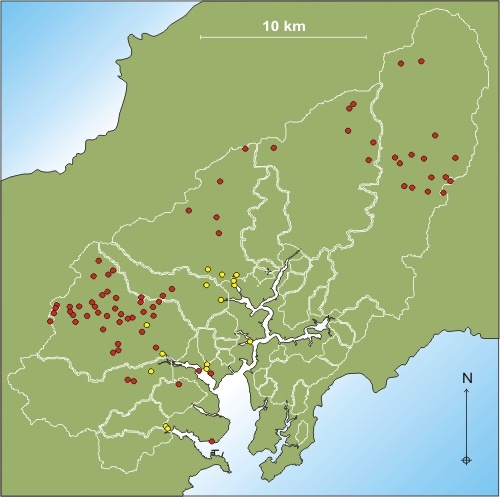
Distribution of documented mines (red dots) and smelters (yellow dots) in the Fal Estuary catchment (after Hamilton Jenkin, 1963; 1964; Dines, 1956). Place cursor over picture for information about individual sites. The white lines represent the catchment areas for individual rivers around the estuary. In reality there were many more mines than this but this map gives a good approximation of the distribution and the effect of mining on individual rivers within the estuary system as a whole. Please note that this only summarises the main documented mines in the area and gives approximate production statistics.
Summary of the history of mining around the Fal Estuary
Tin streaming, the earliest mining activity around the Fal Estuary, probably dates back to the Bronze Age (2500 - 600 BC). Analysis of the chemistry of Bronze Age artefacts (Bronze is an alloy of tin and copper) suggests that in the early Bronze Age the tin for bronze was recovered from south west England. Evidence for early Bronze Age mining in Cornwall comes from the recovery of a number of Bronze Age artefacts recovered from the tin-bearing sediments during later mining activity. Although the exact relationship between some of these artefacts and the surrounding sediments is in some cases questionable, other evidence such as a human skeleton found lying on the tin ground below a small prehistoric cairn at Perran-ar-Worthal is taken to support early Bronze Age mining activity.

Reproduction of a diagram published by Henwood (1873) reporting the discovery of a ?Bronze Age skeleton discovered in the tin-bearing sediments at Perran-ar-Worthal. This and other evidence is taken to indicate that mining for tin in Cornwall dates back to the early Bronze Age.
Other artefacts include a pick axe made of stag horn recovered from tin streaming grounds in the Carnon Valley (Penhallurick, 1986). The continuation of the early tin mining industry through into the Iron Age (600 BC - AD 43) is supported by the presence of evidence for smelting at a number of Iron Age settlements. During the first two centuries of the Romano-British period (AD 43 - 410) there is limited evidence for tin mining, but in approximately the middle part of the third Century the working of tin from southwest England again became important. Evidence includes the recovery of Roman coins and a tin bowl from the tin ground in the Carnon Valley. Evidence for early Medieval (AD 410 - 1066) tin working on Goss Moor comes from the discovery of a probable 5th Century brooch from streamworks in that area.
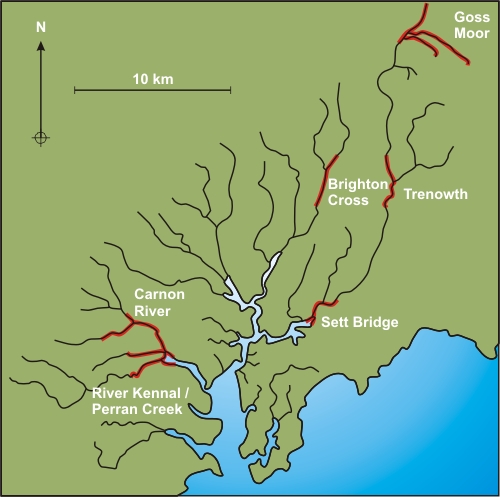
Location of major tin streaming works (marked in red) in the Fal river system
Within the Fal Estuary area, streamworks were located within the valleys of the Carnon River, the River Fal and the Tresillian River. The Carnon River streamworks extended as far upstream as Twelveheads and were repeatedly worked from the Bronze Age through until the early 19th Century. On Goss Moor, north of St. Dennis, the head waters of the River Fal were extensively streamed for tin again from at least the Romano-British period onwards. Tin streaming was also undertaken in the upper reaches of the Tresillian River, with extensive but shallow workings stretching between Ladock and Brighton Cross.
During the Medieval (AD 1066 - 1540) and post Medieval period there is extensive archaeological and documentary evidence for the expansion of mining activity, initially through tin streaming and then by hard rock mining. The documentary evidence for the amount of tin production dates back to the 12th and 13th centuries. The production of smelted tin metal (so called white tin) had stood at about 300-400 tons per annum for much of the 13th Century and began to increase rapidly in the second quarter of the 14th Century to 700-800 tons by the early 1330s. The incidence of outbreaks of plague then caused the population to collapse and a related collapse in the amount of tin production until the latter part of the century. This pattern of early century boom, mid century collapse and then late century recovery was repeated in the 15th and 16th centuries.

An early diagram showing the activities involved in the mining of river placer deposits, such as the tin bearing sediments of Cornwall (from Agricola, 1556).
In the 17th Century tin production again varied, but there was a significant increase in tin production between 1650 and 1700. Tin production in the early part of the 1700s had been less than 1500 tons annually, increasing to 2500 tons by the 1750s and 1760s and to over 3000 tons by the late 1780s (Burt, 1998). In addition, the deeper tin workings also highlighted the presence of extensive copper mineralisation.
Initially this mining was primarily based around tin streaming, but increasingly production was from underground workings including lode-back pits, openworks and shafts. Lode-back pits are shallow pits or shafts that follow the line of mineralised lodes which crop out at the land surface. Openworks, which are also referred to as ‘coffins’ are opencast quarries, which occur along the length of the lode. This type of mining activity had certainly started before the late 13th Century. Shaft mining is synonymous with underground mining where rather than working the lodes at surface they were worked at depth. It is also likely that this type of mining had also commenced by the late 13th Century. Shaft mining led to a number of new technical challenges. For example, the use of adits to drain underground workings was certainly in widespread use by 1602.
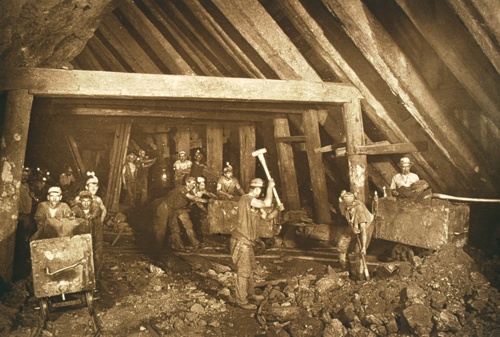
By the late nineteenth century mining operations employed thousands of people and were very large scale. This image, taken in 1893 shows Dolcoath Mine in the Camborne-Redruth mining district.
Copper mining expanded rapidly in the early part of the 18th Century and for a while was more important to the Cornish economy than tin. Zinc production was gradually introduced from the early 19th Century and by the 1850s accounted for up to a third of the national output. Production fell off in the late 1860s and early 1870s but recovered again in the late 1870s and early 1880s. Lead and silver had also been produced from the early Medieval period onwards and by the early 19th Century, Cornwall was probably one of the country’s largest lead producers (Burt, 1998). This lead production has had a marked impact on the sediment geochemistry in areas such as the Gannel Estuary on the north coast of Cornwall (Pirrie et al., 2000a). Arsenic was produced from the mid 19th Century onwards as a joint product from many tin or copper mines and Cornwall became the principal source of world arsenic supply through to the start of the first world war. Other less important mined ores included iron, manganese, tungsten, antimony, bismuth, cobalt and uranium.

Although not in the Fal Estuary catchment, this image of the Pool area (taken in 1893) provides a lasting impression of the scale of the mining industry and its affect on the environment at this time.
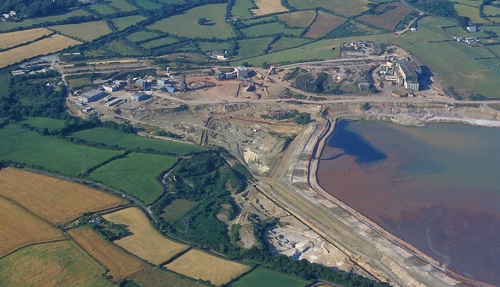
Wheal Jane was an important mine up until its closure in 1991 although the processing plant and tailings pond (lower right of photo) continued in use treating ore from South Crofty until 1998. Photograph courtesy of Steve Hartgroves at the Cornwall Archaeological Unit.
In addition to metal mining, the extraction of china clay, particularly in the St. Austell area has been very significant. The presence of china clay in Cornwall was first recognised in 1746. By the mid 1840s production had reached 30,000 tonnes per annum and thereafter the industry grew steadily reaching an output of 500,000 tonnes per annum by 1889. During the period 1889-1950, production remained relatively constant with an average annual production of 600-700,000 tonnes. Rapid expansion of the industry between 1950 and 1970 took production up to about 2.5 million tonnes per annum.

Today china clay is mined using a high pressure water jet. Historically the waste products from this mining were discharged directly into the adjacent river systems such as the River Fal.
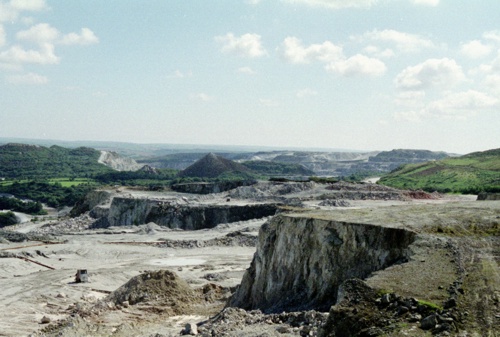
The St Austell area is one of the world's largest producers of china clay however current estimates suggest that there is approximately 450 million tonnes of waste material stockpiled in the area (Bristow, 1998).